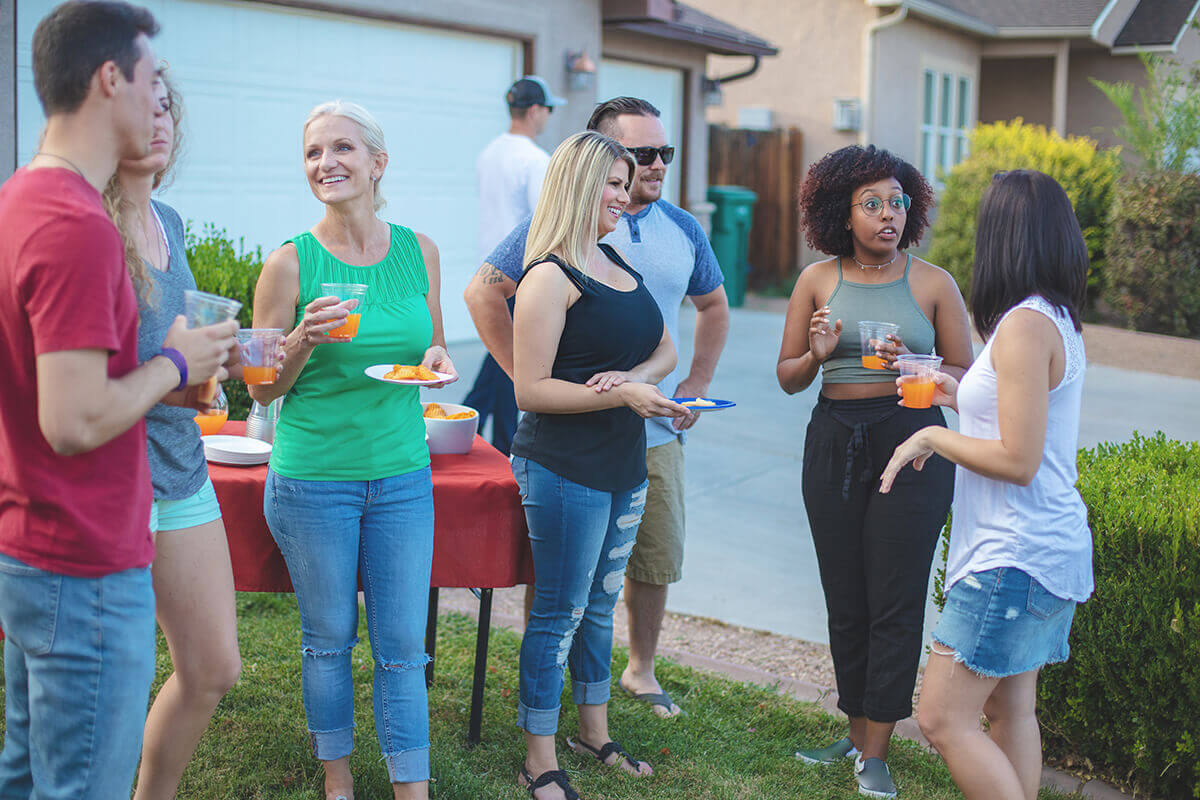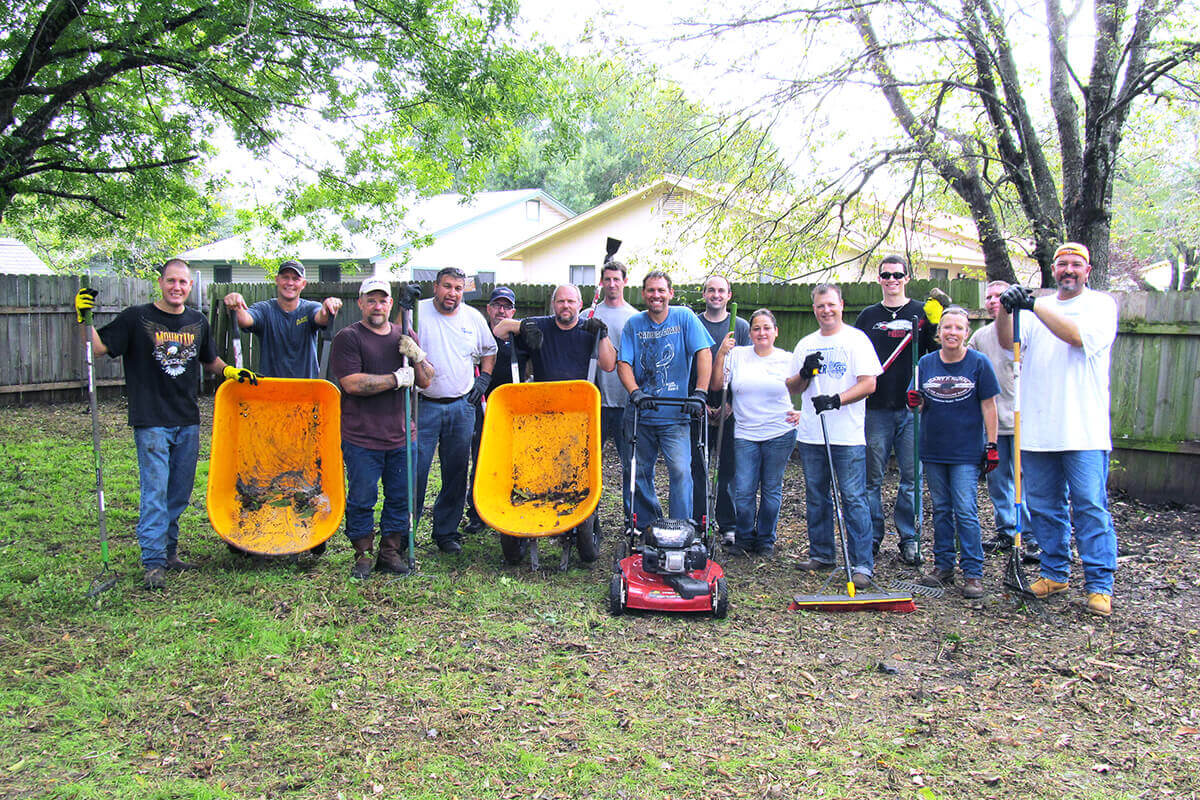Introduction
A neighborhood association is a group of residents who meet regularly to accomplish specific goals in their neighborhood. The association may include homeowners, renters, business owners, school faculty or staff, church officials and members of non-profit organizations. Depending on the goals of the group, meetings may be held twice a year, once a quarter or every month. The biggest misconception about NAs is they are the same as HOAs.
What is the difference between a Homeowner’s Association and a Neighborhood Association?
- An HOA is a legally binding entity considered a political subdivision of the State.
- Membership is mandatory.
- HOA members agree to be held to the deed restrictions and the HOA often owns and maintains property (pools, parks, roads, etc.).
HOA’s will generally have a management company that handles the day-to-day needs of the community.
A Neighborhood Association is a voluntary group with no legal ability to enforce dues or restrictions on residents. NAs are made of volunteers working together to address an issue in their community and to organize social functions.
Each neighborhood is as unique as the residents that inhabit them. It’s the residents who are best able to create the kind of neighborhood they desire by working together. Coming together with your neighbors only when controversial issues arise limits your effectiveness and the ability of residents to determine the future picture of the neighborhood. Organizing a neighborhood association is an excellent way to improve your neighborhood and develop a spirit of community and pride.
Neighborhood associations help identify challenges and concerns, support change and improvement efforts, help resolve conflicts, provide volunteers for community initiatives, represent the neighborhood to elected officials and find resources to make the neighborhood a better place to live.
Before forming a neighborhood association, it is important to define or understand the goals of the proposed neighborhood association. Some goals may include:
- Helping neighbors get to know each other by hosting social events
- Making physical improvements such as painting a mural, or organizing a neighborhood clean-up
- Assembling a Block Watch to reduce crime
- Organizing to share opinions with public officials
- Share information and resources with neighbors about city and community programs
Organizing Your Neighborhood
Step 1: Make sure that a neighborhood association doesn’t already exist in your area. This can be accomplished by searching City View or by contacting the City of Round Rock Neighborhood Services. Our Neighborhood Services Coordinators will assist you with identifying past and current associations within your proposed boundaries. If an association already exists, they will introduce you to the board and their representatives.
Step 2: Form a steering committee with a small group of neighbors who share an interest in your neighborhood and are willing to invest their time and energy into making improvements.
- Invite interested neighbors to a meeting and begin by asking a few basic questions:
- Why do you think we should organize?
- What are the issues that need to be addressed?
- What resources are available in the neighborhood?
Ideally, you want a team of four to six neighborhood members. Neighborhood Services Coordinators are here to help you establish and sustain your neighborhood association by:
- Providing a meeting venue
- Advertising
- Advising and facilitating discussion
- Presenting at the meeting
- Identifying available resources
- Drafting documents (Bylaws)
- Coaching, motivating, and building partnerships
- Liaison with City Staff
Step 3: Plan and organize the first neighborhood meeting. Committee members should plan a strategy for gathering and encouraging residents to attend.
- Conduct a neighborhood Inventory: The inventory consists of a collection of facts about the neighborhood including information on residents, types of homes, area businesses, churches, and schools. This list will help you get more neighbors involved in the association and its activities. You may need to go door to door to obtain this list.
- Develop a preliminary neighborhood plan. Problems and concerns typically addressed by neighborhood associations include crime, physical improvements, traffic, streetlights, preserving unique features of the neighborhood, zoning concerns or meet and greet for neighbors.
- Draft an Agenda
- Identify a meeting venue
- Publicize the meeting
Step 4: Holding the first neighborhood meeting:
- The steering committee can introduce the purpose and begin to establish the boundaries of the association
- As a group, discuss the vision of the association
- Establish and prioritize goals for the neighborhood
- Select an action committee to address your first major issue/goal/project
- Identify short term leadership roles
- Determine on future meeting dates
- Establish a means to contact attendees

Forming a Neighborhood Association
As the neighborhood association grows a decision to formalize the association should be made. Future meetings should focus on the drafting of bylaws, selection of permeant leaders, and establishing action committees.
Advantages of registering a formal neighborhood association:
- Matching Grant Program
- Block Party Trailer and Permitting
- Sign Topper Program
- Annual Training and Awards Conference
- Liaison with City Staff
- Additional neighborhood cleanups featuring the Tool Lending Center and volunteers
Step 1: Establish Bylaws that will govern the internal affairs of the association. A sample set of bylaws can be found below. Once bylaws are written and adopted by a vote of the membership, they should be reviewed periodically to assure that the association’s purpose has not changed. They should be distributed to each member and placed on file with Neighborhood Services.
Reviewing bylaws on a regular basis ensures the rules are continuing to meet the needs of the group. Whenever bylaws are updated, they should be re-distributed to the membership and re-filed with Neighborhood Services.
Step 2: Elections should be held annually for your neighborhood association to elect a Board of Directors. These officers will handle the business of the neighborhood association throughout the upcoming year. Your association’s bylaws should specify the positions and the general framework of your electoral process. Descriptions can outline the responsibilities of the board and other individual officer positions. Don’t be intimidated by the titles, the time commitment required by each officer is minimal and with support of the group can be a very rewarding experience.
Chairperson or President
This person is responsible for the overall leadership of the association board and sets the agenda and facilitates all meetings. It is important for this person to be objective and judicial. A chairperson should never dominate discussions. The chair keeps the meeting running smoothly while allowing participation and is the person who makes sure people keep to the agenda, both in content and timing.
Some duties that are usually the responsibility of the chairperson are:
- Making sure members are notified about meeting dates, times, and locations.
- Represent the association in a public capacity.
- Keep the meeting focused and within the allotted time frames as outlined in the agenda.
- Mediate arguments between members as they arise.
- Clarify decisions made by the group.
- Have an organized agenda.
- Bring the issues to a vote as needed and in an orderly manner.
- Review tasks and make assignments.
- Ensure that all members follow bylaws and procedures.
- Give credit and recognition for accomplishments.
- Follow up on decisions made at meetings.
- Meet with successor and transfer records, files, etc.
Vice Chairperson or Vice President
This person assists the chairperson. The person serves in an advisory capacity to the Chair. In absence of the chairperson, the vice-chairperson conducts the meetings and exercises all of the usual duties of the chairperson. The Vice Chairperson should also be a person with strong leadership qualities.
Some of the responsibilities of the Vice-Chairperson are:
- Effectively manage and facilitate meetings in the absence of the Chair.
- Step into the Chair position in the event that the Chair is unable to complete his or her term.
- Follow-up on tasks assigned to members of the association.
Secretary
The secretary records the minutes of the meetings and makes sure that copies of the minutes, agendas, and other records are available for the board and the public.
Some responsibilities of the Secretary are:
- Record the minutes during all association meetings.
- Maintain current and comprehensive membership records.
- Record all of the official correspondence of the association.
- Pass along important information to be included in association newsletters.
Treasurer
The treasurer is responsible for the funds of the neighborhood association. Someone should be selected that will take the duties of the position very seriously since the fiscal condition of the association is crucial to the future wellbeing of the group.
Typical duties of Treasurers are to:
- Pay all the association’s expenses in a timely and accurate manner.
- Collect and deposit all funds received by the association.
- Maintain a financial accounting system that is adequate and thorough for the association.
- Collect voluntary dues from members of the association.
- Submit periodic financial reports to the board.
Step 3: To do business as an association in the State of Texas, the least you must do (legally) is to file and receive an assumed business name. Basically, an assumed business name lets the public know with whom they are doing business. Unlike a corporation, an assumed business name does not provide liability protection to the people in the organization or business.
Step 4: Neighborhood associations should have a federal tax identification number. The number acts as a Social Security number for organizations. The number can be used to open bank accounts, file IRS tax forms, apply for tax exempt status, etc. Organizations do not need to be incorporated to receive a tax identification number.
Step 5: Incorporation is optional to all organizations and may be beneficial to your neighborhood association. When a non-profit organization incorporates, it helps define the group and the organization is deemed trustworthy. Incorporation also protects the personal liability of group members
Step 6: The federal government gives tax exempt status upon application to the Internal Revenue Service. This status permits large contributors to your group to deduct contributions from their income tax. Tax-exempt status is almost mandatory if your group plans to apply for foundation monies or solicit large donations.
A fear many board members have is being held liable for board actions. When organizations incorporate, individual board members can be protected from becoming financially liable because of board service. A provision in the bylaws may be placed to indemnify board members in the event they are sued because of board service. Indemnification promises that the corporation will repay the board member for costs of defending themselves in lawsuits and/or for costs of judgements against board members. If desired, you should consult with an attorney to assure that you properly provide for indemnification of board members. However, such indemnification is pointless if the organization does not have funds available to cover the board member’s costs in certain legal actions. Therefore, larger organizations often carry directors’ and officers’ liability insurance. Additionally, for a low additional annual fee, several individual homeowners’ policies may provide coverage for policyholder’s volunteer activities. Check with your insurance agent to see what volunteer coverage is available.

Developing and Maintaining the Organization
Once you have your neighborhood association up and running, you must keep members interested and involved. Recruiting members is important for the longevity of any organization. Initially, many groups attract members through well-publicized meetings on issues that concern projects involving lots of people. Once the project is completed or a problem is solved, active members may dwindle away. Many organizations experience this problem, so you need to be creative to avoid this dilemma.
Building Memberships
- Have association members go door-to-door calling on their neighbors. This can be a week-long effort or be done in a day. You could have a membership drive and then have a party for the members that volunteered in the effort. Your members would have fun and would have an opportunity to share experiences with each other.
- Pass out printed materials to encourage residents to get involved. It could be as simple as a letter from the president or a brochure with details on upcoming events or issues. Members should also carry membership forms with them and offer both immediate and mail-in membership opportunities.
- Designate block captains that can pass out flyers and newsletters to prospective new members, welcome new residents, serve as a sounding board for specific problems or issues on the block, and organize volunteers to help with activities they might be interested in.
- Community gatherings or other events are also a great way to recruit new members. Sponsor a booth at a community festival or event. This is a great opportunity to talk to people in your area. Have membership sign-up sheets available. You can also have information packets about the association to hand out at events.
Keeping members involved can be quite challenging. For every member that is active in the association, there are probably two who would be involved if they were properly motivated.
Retaining Active Members
- Help new members find a place in the association. Many will offer to help but will not know where to start. Organize a list of volunteer activities and have those who want to help sign their name next to activities that they would be interested in assisting. This will be a great start for your new members.
- Always welcome new members and attempt to make them feel at ease with the group. Officers and other members should watch for new faces at each meeting and welcome them. New or potential members should be introduced to someone who lives near them. Designate an official “greeter” at every meeting.
- Avoid the appearance of cliques. New people who see the same people running every project will feel excluded and may not return. Different people should be appointed to positions of leadership. This will help create a sense of belonging.
- Encourage new ideas and input at all levels of the organization. People who are new in the organization can see things in a new light and provide new solutions to old problems. New perspectives can assist the whole group in problem solving.
- Every meeting should represent the strongest commitment to organization. Busy people will not attend meetings or involve themselves in organizations they consider to be a waste of time. Have a well-planned meeting will also display a sense of accomplishment from the beginning. Have a written agenda for every meeting and stick to it.
- Maintain current membership records. Keep a file with members’ names, addresses, phone numbers, family member names, occupations, special talents, areas of interest, etc.
- Being part of a neighborhood association is not all work. Have fun as well. Sponsor parties and celebrations to get to know your neighbors better. Your events should appeal to all, including children. This will foster a strong sense of community spirit among your neighbors.
- For passing out flyers members may canvass by leaving or taping flyers to doors without a permit.
- Create welcome baskets for new residents who move in. They can include menus and coupons to local restaurants, cookies and the new resident guide from the City.
Meetings
Regular meetings are important so that members are informed of current and future issues and projects, as well as the accomplishments of the group. It is also an excellent opportunity to give recognition to members and committees who have contributed a lot of their time to the association.
One thing to remember about meetings is that it isn’t always necessary to call a full group meeting to make minor decisions. When minor decisions need to be made, using an executive committee or board is better. Most groups have a board meeting once a month unless something important requires an additional meeting. To prevent member burnout, meetings should not be longer than one hour.
If a regular meeting is scheduled, but there really isn’t anything important to discuss, then create something. This can be done by inviting a guest speaker, organizing a neighborhood tour, or having a potluck. The Neighborhood Services team has a vast contact list of special guests from the City, County or any outside agency your neighborhood would be interested in. They would be glad to help arrange guest speakers. Don’t cancel the meeting altogether because it is important for groups to have contact on a regular basis. One important part of holding a meeting is its location. Choose a place that is centrally located and familiar to the neighbors. The location can set the mood and the friendliness of the meeting. Try to estimate the number of people that will attend. The room should be comfortable but not so large as to make the people feel lost.
The meeting room should be arranged in a way that will encourage people to participate. The chairs can be arranged in a semi- or full circle so that everyone can be seen. Avoid having all the chairs facing the speaker as in a typical classroom. Do not use tables unless you need them to hold drawings or literature because they can form barriers to communication. However, a large table with everyone sitting around it can be used if people need to write.
Be sure to have enough copies of the agenda available when members arrive for the meeting. The Neighborhood Services team can print and bring copies of the agenda to your meeting free of charge but also be sure to distribute it electronically. Members can begin familiarizing themselves with what is to be discussed and will be aware of the order of topics while waiting for the meeting to begin. The agenda should be short and concise.
Many groups are comfortable using Robert’s Rules of Order, but feel free to use whatever method works best for your group. A special effort should be made to ensure that a vote truly represents the desire of the group. Keep meetings orderly and democratic.
Committees
Organizations can accomplish their objectives through the dedicated work of committees. The tasks and the types of committees depend on the overall purpose and structure of your neighborhood association.
- Encourage members to participate in the association and the committee planning process.
- Define and discuss the goals and objectives of the committee.
- Provide reasons for the actions to be considered by the committee and the neighborhood association.
- Give recognition to members and committees who have contributed to the advancement of the neighborhood association.
- Make meeting time and committee work as productive as possible. No one wants to feel their time is being wasted.
- Help members develop communication skills.
- Some examples of committees would include: Social, welcoming, yard of the month, etc.
Work Plans
Making work plans for each project will help members stay focused and on target. Meeting goals, planning events, recruiting volunteers, and strengthening the organization will be easier when time is taken to prepare an outline of expectations and objectives, and then make a plan for meeting those goals.
Bookkeeping
All neighborhood associations encounter a sum of money for one reason or another. A management system needs to be in place for dealing with any funds handled by the association. The best thing to do is to open a bank account for the group.
With so many different types of accounts available, how do you know what kind of account to set up? Research needs to be dedicated to finding out the benefits of certain types of accounts and a decision can be made on an account that will be most beneficial for the group. Check with several banks to get the best deal for the group. Whether you are a corporation or just a designated person, either can open a bank account for the group. If you are a corporation and have nonprofit status, you may be eligible to receive free or reduced fee banking privileges at some banks.
Even though many organizations do not have much money, it is important to keep track of whatever money does come into or go out from your organization. It is a good idea to have an accountant or bookkeeper help you set up a set of books from the start, then the Treasurer or someone who feels comfortable with numbers and figures can take on bookkeeping responsibilities. The sooner the system is set up, the easier it is to keep accurate financial records.
- Dues suggestions? Most NAs have yearly voluntary dues of around $25.

Taking Action
Raising Funds
Neighborhood associations need to raise funds for regular operations and special events and projects. The ways that a group raises funds are limited only by the members’ imaginations. Funds can be raised by the group itself, private donations, or private and government grants.
A fund-raising committee should be selected to prepare a budget and to oversee projects. Often people who are well known and liked in the community are successful project leaders. This person should also have good contacts in your local business area. Most importantly, the person should have the time to dedicate for the fundraising.
Publicity
Publicizing your neighborhood association’s activities is very important. You will be planning several great programs for your neighborhood, so don’t keep them a secret. Share them with as many people you can. This will help others in the neighborhood join your efforts and take part in making a difference. Publicity is also an easy way to increase membership in your association.
Neighborhood projects and activities
Organizing neighborhood projects can provide opportunities for neighbors to work together and continue to stay active. It also builds the credibility of the group as a moving force in the community.
The City of Round Rock Neighborhood Services is here as a resource for any and all NA members. It’s our job and desire to help them succeed.


